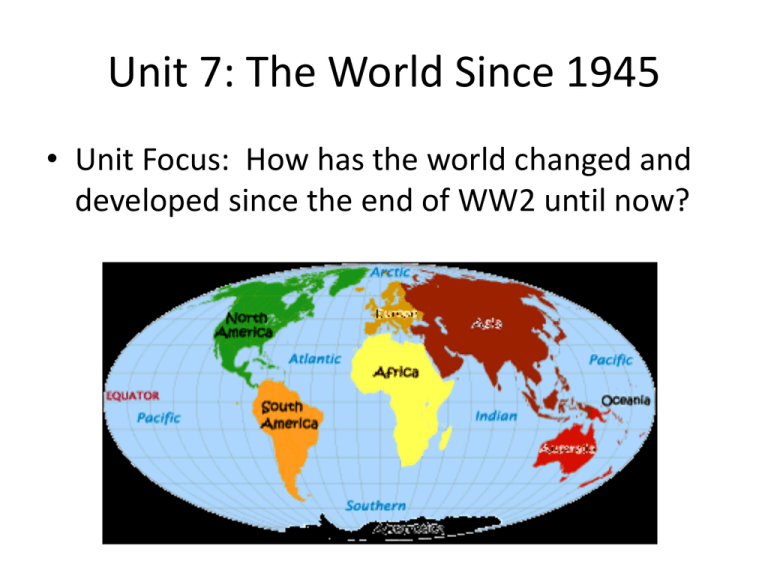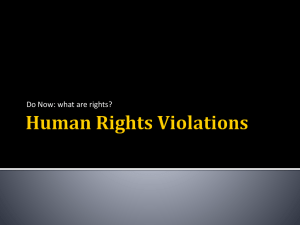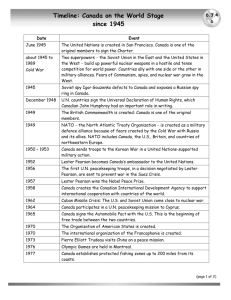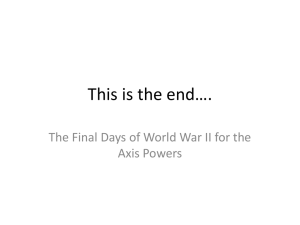Unit 7: The World Since 1945 - Mr. Gay's Social Studies Classes
advertisement

Unit 7: The World Since 1945 • Unit Focus: How has the world changed and developed since the end of WW2 until now? Chapter 30: The Cold War (1945 – 1991) Chapter Summary • For almost a half century after World War II, the Cold War loomed over Europe—pitting the West, led by the United States, against the Soviet Union (Russia). Despite the constant threat, Western Europeans and their North American allies enjoyed their most rapid and sustained economic growth since the Industrial Revolution. The Soviet Union and its Eastern European satellites also made efforts to rebuild after the war but were held back by Stalin's repressive policies. In the 1980s, efforts at major reform unleashed forces that brought the collapse of communism and an end to the Soviet Union. Chapter 30: The Cold War (1945 – 1991) Chapter Outline • Section 1: The Cold War Unfolds – The Cold War between the United States and the Union cast a shadow over the world for more than 40 years. Soviet • Section 2: The Industrialized Democracies – As a result of government policies and international cooperation, the people of the industrialized democracies—the United States and Canada, Western Europe, and Japan—have enjoyed freedom and prosperity. • Section 3: Communism Spreads in East Asia – In the late 1940s, communism made advances in East Asia. • Section 4: War in Southeast Asia – Southeast Asian nations sought independence but also fell into divisive conflicts in the decades after World War II. • Section 5: The End of the Cold War – After years of communist rule, the Soviet Union collapsed and was replaced by Russia and other independent republics. After years of Soviet domination, the countries of Eastern Europe were free of Russian control, facing new and sometimes difficult challenges. Ch. 31: New Nations Emerge (1945 – Present) Chapter Summary • At the same time that the Cold War was unfolding, a global independence movement was reshaping the world. Colonial rulers gradually relinquished their hold over their overseas possessions. As independence celebrations ended, new countries and governments were faced with the task of nationbuilding. Ch. 31: New Nations Emerge (1945 – Present) Chapter Outline • Section 1: Independent Nations of South Asia – After winning independence, Hindu India and Muslim Pakistan pursued separate roads to modernization. • Section 2: New Nations of Southeast Asia – Southeast Asian nations sought independence but also fell into divisive conflicts in the decades after World War II. • Section 3: African Nations Gain Independence – As many African nations won independence in the 1950s and 1960s, they held great hopes and faced great challenges. • Section 4: The Modern Middle East – Three forces shaping the modern Middle East are nationalism, religious and cultural diversity, and access to resources such as oil and water. Ch. 32: Regional Conflicts (1945 – Present) Chapter Summary • Many areas of the world have faced regional conflicts since the end of World War II. Fighting broke out in several areas of Africa as colonies gained independence, and in some African regions internal conflicts continue today. Ethnic and political conflicts have affected Ireland, the Balkans, Chechnya and Sri Lanka. In the Middle East, the Arab-Israeli conflict has come to define relations between nations in the region. Ch. 32: Regional Conflicts (1945 – Present) Chapter Outline • Section 1: Conflicts Divide Nations – Political, religious, and ethnic unrest has disrupted lives in many regions of the globe. • Section 2: Struggles in Africa – As many African nations won independence in the 1950s and 1960s, they held great hopes and faced great challenges. • Section 3: Conflicts in the Middle East – The Middle East has been the focus of conflicts that have had an impact far beyond the region. Ch. 33: The Developing World (1945 – Present) Chapter Summary • Development is the process of building a stronger and more advanced economy and creating higher living standards. The nations working toward development in Africa, Asia, and Latin (South) America are known collectively as the developing world. Each of these nations faces challenges of development as each tries to create better lives for its citizens. Ch. 33: The Developing World (1945 – Present) Chapter Outline • Section 1: The Challenges of Development – Education, technology, the environment, and the economy: all of these, as well as others, are factors in development. • Section 2: Africa Seeks a Better Future – Since 1945, more than 50 new nations have been born in Africa, each trying to improve the daily lives of its citizens. • Section 3: China and India: Two Giants of Asia – China and India are home to two-fifths of the world's people, and their economies have grown stronger over the past 60 years. • Section 4: Latin America Builds Democracy – Despite setbacks, Latin American nations have tried to sustain economic growth and overcome a legacy of poverty and social inequality. Ch. 34: The World Today Chapter Summary • Today's world is a culmination of the events and developments of the past centuries. Technological and economic changes have created new links between people around the globe. These connections worldwide have also made people and societies more aware of the challenges that face the world today and in the years to come. Ch. 34: The World Today Chapter Outline • Section 1: Industrialized Nations After the Cold War – The end of the Cold War saw old empires crumble and new nations emerge, along with new global economic trends. • Section 2: Globalization – Globalization defines the world of the post-Cold War, integrating economies, politics, cultures and societies around the world. • Section 3: Social and Environmental Challenges – Globalization has brought all kinds of social and environmental issues to the world's attention, such as poverty, disease, environmental threats and human rights. • Section 4: Security in a Dangerous World – Just a decade after the end of the Cold War, people and nations are worried about attack—from different, unpredictable sources. • Section 5: Advances in Science and Technology – Since 1945, scientific research and technological development have had a transforming effect on human history. Discussion Questions Ch. 30 - 34 • What was the Cold War and what impact did it have on the world? • What are some of the causes of the struggles and conflicts taking place around the globe in modern times? • What kind of challenges do developing nations face today? • What is globalism? – What are the possible positive and negative impacts of globalism?







